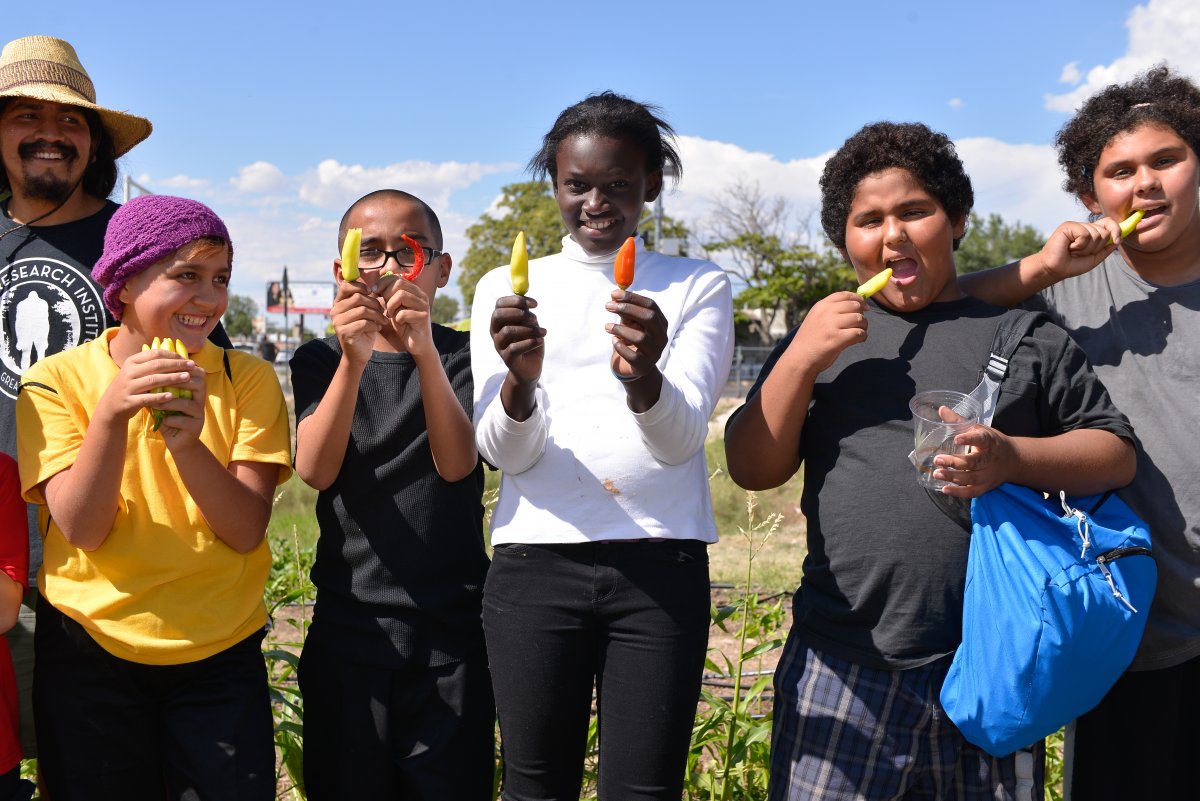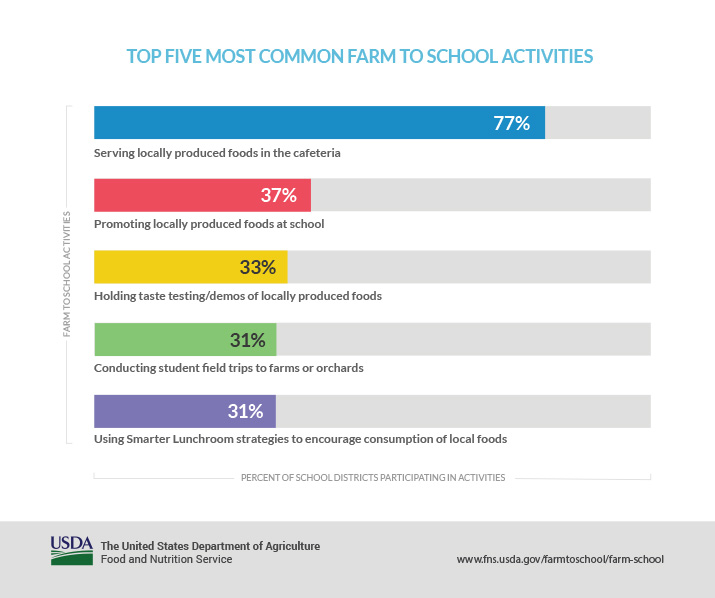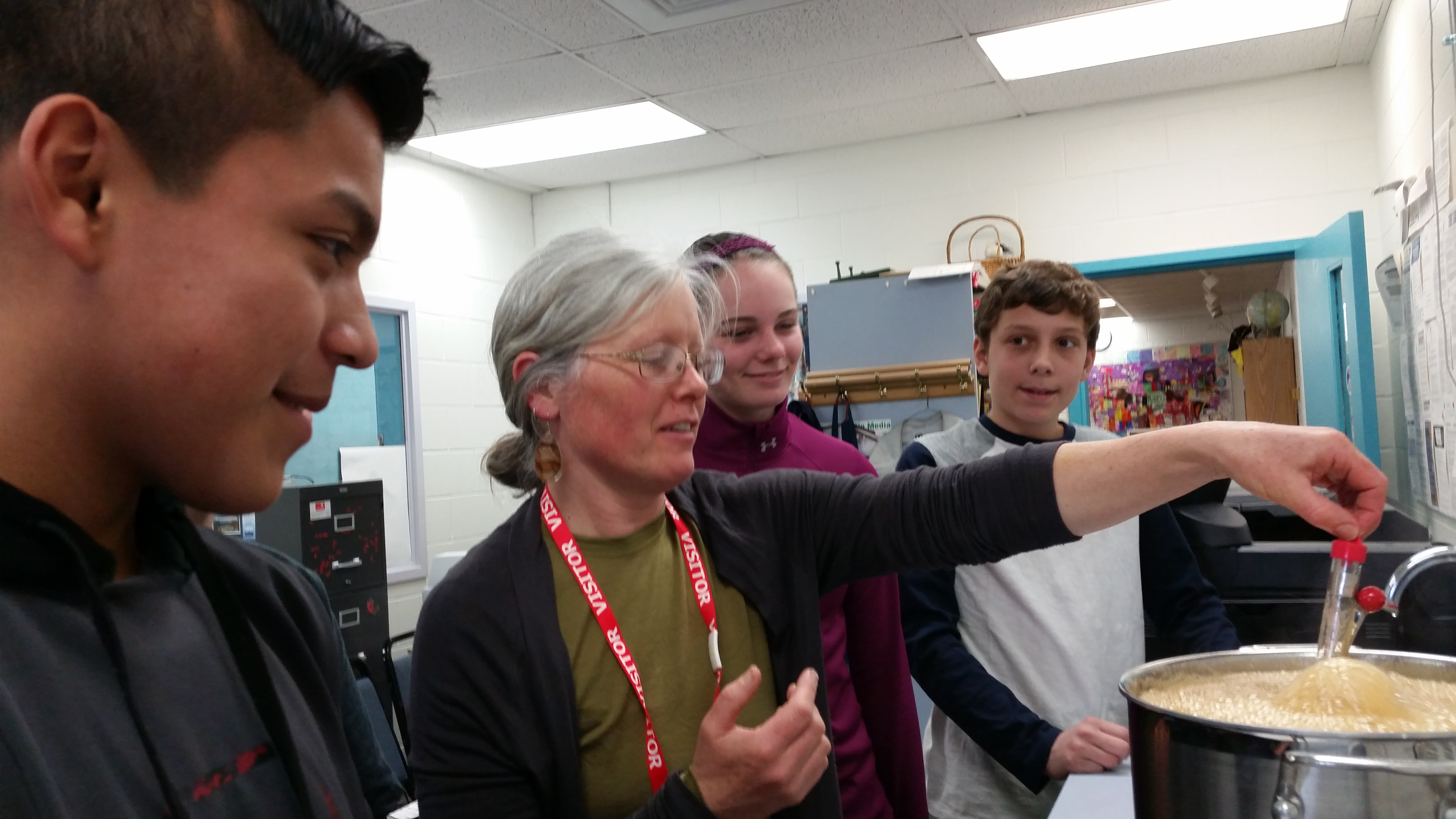Program: Farm to school
Takeaways
Farm-to-school programs, which combine purchasing, promoting, and serving local foods with healthy eating and nutrition education objectives, align closely with hospital strategies to address obesity and diet-related disease. This brief offers recommendations for ways hospitals can enhance farm-to-school efforts, supporting students’ health and strengthening local and regional food systems.
- Farm-to-school programs increase students’ exposure to fresh, healthy local foods.
- With the focus on fresh local foods, farm-to-school activities promote healthier diets.
- Farm-to-school experiences are associated with students’ increased consumption of fruits and vegetables.
- Annually, the purchase of local food by schools results in an estimated $1 billion in additional local economic activity nationwide.
Farm-to-school initiatives build relationships between schools and local farms, support student access to local food, create new opportunities for education and health promotion, and benefit local economies. Increased support at the national level combined with growing state and local efforts has fueled expansion of farm-to-school activities in recent years. These activities align with the Centers for Disease Control and Prevention recommended strategies for obesity prevention. Hospital support for farm-to-school programming can take the form of financial contributions to fund activities, staff conducting food and nutrition education, and technical assistance to support local purchasing.
What is farm to school?
Farm to school encompasses a range of activities, including local food purchasing, hands-on, garden-based learning, farm field trips, cooking demonstrations, and integration of food-related information into classroom curriculum. The mix of activities is unique to each school setting.

Farm-to-school activity: Widespread and growing
Farm-to-school efforts have increased significantly in the last two decades. In 1998, around 10 farm-to-school programs existed in the United States. The United States Department of Agriculture (USDA) 2015 farm-to-school census found that 42 percent of districts surveyed nationwide now engage in farm-to-school activities. Overall, more than 42,000 schools reported involving 23.6 million students in farm-to-school programming. Serving local foods as part of school meals is the most commonly reported activity, and 63 percent of school districts report carrying out three or more farm-to-school activities. Other core activities include holding taste tests or cooking demos, farm field trips, school gardens, and use of “smarter lunchroom” strategies.
- Buying local: More than 77 percent of schools buy local foods as part of their farm-to-school efforts. Buying local requires investments of time and resources. Sourcing local foods can be associated with additional costs which is challenging for schools with limited funds for food service. The additional expenses faced by schools may include equipment to store fresh foods and increased labor to prepare fresh food. However, farm-to-school programs have been found to positively influence student meal participation (increases ranged from 1 to 16 percent across seven studies), which boosts food service revenue.
- Gardens: Nationwide, 7,101 school gardens offer students hands-on learning experiences and the opportunity to see first-hand where food comes from and are often used in teaching core subjects, such as math and science. Exposure to school gardens has been found to make students more inclined to try new foods and to adopt healthy eating behaviors, namely increased fruit and vegetable consumption.
- Education: Food and nutrition education is a core component of farm-to-school activities. Farm-to-school education takes the form of lessons integrated into core subjects (e.g. math and science), taste tests, cooking demonstrations, enhanced lunchroom strategies, and field trips. Students who participate in farm-to-school activities display increased knowledge of what constitutes healthy eating and also greater understanding of agriculture, the environment, and where food originates. The exposure to new, nutritious foods can prompt students to make healthier choices, influencing long-term dietary patterns and health outcomes. Educational activities also often include outreach to families, which serves to reinforce school-based efforts and further spread information about local foods and healthy eating. For instance, harvest-of-the-month programs, which highlight specific local foods, produce family newsletters and recipes for home use.

Farm viability, economic growth, and community food security
Farm to school creates valuable new markets for local farms and can be a driver for local economic growth. Farm-to-institution sales are an alternative market (others include community-supported agriculture and farmers markets) being pursued by small and mid-sized farms to diversify their customer base and increase their revenue. With new markets comes new opportunities for farms, such as contracting with institutions to grow specific crops.
The USDA estimates that schools procured $790 million in local food product during 2013-14, and farm to school sales boost individual farmers’ income by five percent (on average). The benefits of farm to school extend into the community. Overall, the USDA estimates that school efforts to buy local may result in a nationwide local economic impact of $1 billion dollars annually, including the creation of additional jobs in the community. By building the local food economy, farm to school also supports greater community food security.
Farm-to-school activities also offer important social benefits. Farm to school increases the visibility of farms and draws attention to their positive contributions to community and environmental health. Activities carried out as part of farm-to-school programming also enhance community cohesion by creating opportunities for social interactions.
![Students plant the Healthy Living Garden at Orange Center Elementary [Orlando Health]](/sites/default/files/inline-images/OCE%20Garden%208.jpg)
Support for farm to school
Financial support for farm-to-school programming comes from federal, state, and local government and community organizations, representing cross-sector interests (public health, education, agriculture, economic development). In many parts of the country, school efforts are supported by state-based organizations, regional, and national networks focused on farm-to-institution and local food system development.
- USDA and federal policy: The USDA Farm to School Program provides support to farm-to-school efforts, including research, grants, and technical assistance. The USDA has numerous grant and loan programs that provide funding to support all aspects of farm to school, including planning, training staff, and purchasing equipment for storing and preparing fresh foods.
- National Farm to School Network: The National Farm to School Network has more than 15,000 members, curates an extensive collection of resources to support farm to school, and leads advocacy efforts for farm-to-school legislative action.
- State legislation and funding: States provide essential support to farm-to-school programs through legislation and funding. A National Farm to School Network survey found 40 states and Washington D.C. had enacted legislation related to farm to school as of 2014. State farm-to-school legislation is associated with strong farm-to-school programs.
- Food policy councils: Across the country, food policy councils have helped establish and expand farm-to-school activity by securing funds for activities, engaging in research and advocacy, and organizing community support for local efforts. For instance, the Michigan Food Policy Council Institutional Procurement Task Force helped pass the state’s farm-to-school procurement act, which included a pilot project to increase meal reimbursement by providing an extra 10 cents per meal that is dedicated to local product.
Farm to health care
Farm to school is part of a broader farm-to-institution movement, including farm to health care, helping to build local, sustainable food production across the country. In 2015, local food sales to institutions accounted for 40 percent of all total local food sales by farmers and ranchers, making institutional sales an important market for these producers. Institutional commitment to local procurement can influence supply chain development and spur market transformation.
Health Care Without Harm and its partners are leading initiatives to leverage institutional purchasing power to expand these efforts. Farm-to-institution networks have emerged in New England and Michigan to mobilize institutions, address supply chain issues, and enhance cross-sector collaboration.
ProCureWorks, an initiative of Health Care Without Harm and School Food Focus, is increasing access to healthy sustainable regional food products usable across sectors in California.
Local food production yields important social, economic, and environmental benefits by supporting producer viability, increasing community food security, and contributing to the emergence of new business opportunities, such as aggregation and processing facilities. With tens of millions of individuals eating meals at institutions each day, the potential impact of farm-to-institution expansion is significant.

Recommendations for hospital engagement
Despite significant support for farm-to-school programming and evidence supporting its social, economic, and health benefits, program capacity and funding are ongoing issues for local efforts. Through collaboration with schools and farm-to-school program partners, hospitals can play a role in growing these important initiatives.
There are multiple opportunities for hospital engagement in farm to school. Through financial investments, staff time, and equipment and materials donations, hospitals across the country are supporting program expansion and increasing capacity. Hospital staff can contribute to the strong food and nutrition education components of farm to school to reach and engage children and families on the importance of healthy eating. Support for farm-to-school initiatives offer hospitals an opportunity to influence the availability of fresh, local food and to support local producers while increasing connections between producers and their community.
Examples of hospital roles and participation
Northwestern Medical Center, Vt. (Play coordinating role in expanding community’s farm-to-school initiatives)
![]() Northwestern Medical Center
Northwestern Medical Center
Franklin and Grand Isle Counties, Vt.
Healthy Roots Collaborative
Healthy Roots Collaborative, a program of Northwestern Medical Center [link to case study], supports farm-to-school efforts across two Vermont counties and is a member of the Vermont Farm to School Network.
Healthy Roots works with 28 schools on farm-to-school activities. Its support ranges from helping to develop contract language to facilitate buying local to hosting taste tests and assisting schools with farm-to-school curriculum.
Gundersen Health System and Mayo Clinic Health System, Wis. (Play coordinating role in expanding community’s farm-to-school initiatives)
![]()
![]() Gundersen Health System
Gundersen Health System
Mayo Clinic Health System-Franciscan Healthcare
La Crosse County, Wis.
Gundersen and Mayo Clinic entered into a formal agreement with Get Active LaCrosse to support the Coulee Region Farm to School program by contributing funding to support technical assistance for schools.
The partnership is enabling LaCrosse County to continue farm-to-school activities in 19 schools. Gundersen and the Mayo Clinic are also members of the 5th Season Co-op, which supplies local food to multiple institutions and further supports increased student access to local foods.
St. Joseph Mercy Ann Arbor, Mich. (Conduct food, nutrition, cooking education)
![]() St. Joseph Mercy Ann Arbor
St. Joseph Mercy Ann Arbor
Ypsilanti, Mich.
Farm at St. Joe’s
The Farm at St. Joe’s, a 25-acre farm on the hospital campus, offers farm tours, tastings, and hands-on learning opportunities, using curriculum developed by staff.
The farm hosts around 1,000 students from 10 area schools and preschools each year. Activities include a lab that uses refractometers to explore the sugar levels of fruits and vegetables.
Orlando Health, Fla. (Provide grant support for school garden)
Orlando Health
Orlando, Fla.
Healthy Living Garden at
Orange Center Elementary
Orlando Health created the Healthy Living Garden at Orange Center Elementary as a means to engage students around food, health, and nutrition.
Located in an area where exposure to fresh, healthy food is limited, the garden gives 345 students access to fresh produce and the opportunity to engage in garden-based health and education activities.
Cheshire Medical Center Dartmouth, N.H. (Provide staff time/technical assistance for grant proposals)
![]() Cheshire Medical Center Dartmouth-Hitchcock
Cheshire Medical Center Dartmouth-Hitchcock
Keene, N.H.
Cheshire County Conservation District-Monadnock Menus
Cheshire secured a CDC-Partnership to Improve Community Health grant to support the Cheshire County Conservation District (CCCD) a community-based partner that facilitates farm-to-institution efforts to rebuild the local food system. The hospital also awards mini-grants for organizations, including schools, to carry out healthy eating activities.
CCCD’s Monadnock Menus met its goal of increasing opportunities for healthy eating by 75 percent. Thirty organizations, including schools, took part in farm-to-institution efforts, and 175,000 pounds of local food was procured.
Learn more
- The USDA Farm to School Census details the level of farm-to-school activity across the country. The site includes a find your district feature, with information on the percent of schools reporting participation, of schools’ local food spend, and of schools with gardens. The USDA website also offers a list of farm-to-school staff contacts, including regional leads. A comprehensive report on the USDA’s Farm to school work can be found here.
- Ten Facts about Local Food in School Cafeterias is a USDA fact sheet that provides an overview of local procurement considerations and opportunities.
- The National Farm to School Network’s Farm to School Benefit Fact Sheet provides detailed information and resources on the economic, academic, and public health benefits of farm-to-school activities.
- The National Farm to School Network’s website offers information on farm-to-school policy and advocacy issues, including summaries of federal policy and a comprehensive survey report on state legislation and proposals.
- The USDA’s 2017 report, Daily Access to Local Food for School Meals, examines the prevalence of school districts serving local each day to determine factors that drive or inhibit serving local food. The report includes estimates for availability of local food in different regions.
- Center for Ecoliteracy’s Making the Case for Healthy, Freshly Prepared School Meals outlines the value of farm-to-school programming for students and communities.
